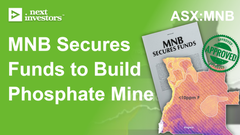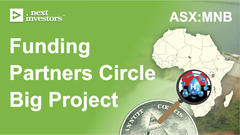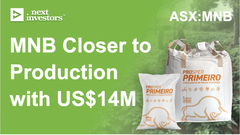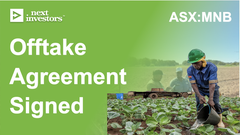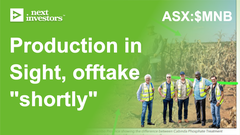Announcing our Wise-Owl 2022 Pick of the Year
Disclosure: S3 Consortium Pty Ltd (the Company) and Associated Entities own 8,645,000 MNB shares and 1,562,500 options at the time of publishing this article. The Company has been engaged by MBN to share our commentary on the progress of our Investment in MNB over time.
Today we are announcing a new Wise-Owl “Pick of the Year” for 2022.
This is an ASX stock that provides exposure to two in-trend thematics - food security and de-carbonisation.
Across our Portfolios, our past Picks of the Year are companies that we believe could deliver us 1,000%+ gains over a 3+ year holding period.
Here are the peak and current returns from our Initial Entry prices of some of our past Picks of the Year:
- VUL +8,225% highest point; +3,285% increase from Initial Entry
- EXR +1,144% highest point; +327% increase from Initial Entry
- IVZ +1.057% highest point; +757% increase from Initial Entry
- PRL +892% highest point; +138% increase from Initial Entry
- ONE +858% highest point; +100% increase from Initial Entry
- EV1 +250% highest point; +23% increase from Initial Entry
Each of these picks are supported by long term investment thematics such as battery metals and energy security.
Note: just because these Investments performed well does NOT mean today’s pick will perform this way. Small cap investing is risky and all sorts of things can go wrong - we list the potential near term risks in our Investment Memo.
Last week this company released the news we were waiting for, which has de-risked this company’s project enough to elevate it to one of our Picks of the Year.
On that note, we are pleased to announce our Wise-Owl 2022 Pick of the Year:
Minbos Resources (ASX:MNB) is progressing two projects at the same time:
- Fertiliser project (project with potential near term cash flow opportunity) - MNB is now building what it expects to be a high-margin phosphate fertiliser supply business (a phosphate mine) in Angola that has the potential to dramatically transform Angola’s food security and crop yields.
Project NPV of US$203.4M (base case) or almost double the base case of US$400M (at then current fertiliser prices), and remaining CAPEX of US$40M - per the Oct ‘22 DFS. - Green hydrogen/ammonia plant (project with blue sky potential) - MNB is also seeking to develop a green hydrogen/ammonia business powered by cheap hydro-electric power in Angola. This would cut the reliance on expensive and carbon intensive natural gas to produce ammonia. Last week MNB executed an MoU on the critical cheap hydro power.
We have been watching MNB as it put together its green hydrogen/ammonia plan, initially viewing the project as a “free option” for MNB to create additional shareholder value.
Now we think MNB has put together a detailed enough plan for the company to stand out from other near-to-production companies that have mature projects.
This is because MNB gives us exposure to a project that is currently under construction (its fertiliser project, first production expected in 2023) with the added blue sky venture (its green hydrogen/ammonia project).
To us, this is what makes MNB stand out from the other advanced stage companies in our Wise-Owl Portfolio, where we focus on later stage companies.
We’ve been Invested in MNB for over two years now, first taking a position in August 2020 at 3 cents per share (price adjusted for a 20-1 share consolidation). We invested again at 8 cents, Top Sliced 35% of the position in the first part of this year (in line with our Investment Plan) and then Invested again at 11 cents in the most recent placement 6 months ago.
Our average entry price into MNB is now 6.37 cents per share.
Today we launch our new Investment Memo for MNB, which covers what we (as investors) want to see the company achieve over the next ~12 months.
We also share our assessment of how MNB performed against our last Investment Memo from March 2022, including:
- How the macro theme played out
- If our “reasons for being invested in the stock” held up
- If the company delivered on the objectives we wanted to see.
- whether any of the near term risks materialised
- How well we executed our Investment Plan
Last week big news broke — MNB signed an agreement (MoU pending successful studies by MNB) with the Angolan power network for the supply of 100%-renewable and installed hydroelectric power from the nearby Capanda Dam for its green hydrogen/ammonia plant.
To put it simply, the cost of power will average US$0.011 (1.1c) per kilowatt hour for the entire 200MW over 25 years.
That is ~90% cheaper than the ~US$0.16 (16c) per kwh currently paid by industry users in Australia and the USA.
(And in the EU prices hit >US$0.50 per kwh earlier this year.)
MNB’s ability to secure extremely cheap (AND green) power is what makes this project so unique, interesting and economically competitive in the global ammonia market.
The agreement sets the terms for MNB’s power supply as follows:
- Initial 100MW at $US0.004 (0.4c) kilowatt hour for 5 years, then 0.8c kilowatt hour for 20 years.
- Subsequent 100MW at $US0.015 (1.5c) kilowatt hour for 25 years.
The agreement sees MNB lock in electricity supply to conduct feasibility studies on developing the green hydrogen/ammonia plant.
Once feasibility studies are complete and if the findings support a move to the construction phase, the agreement binds MNB and the power network to start negotiating to turn the current power agreement into an Electrical Supply Contract, within the commercial parameters proposed by MNB.
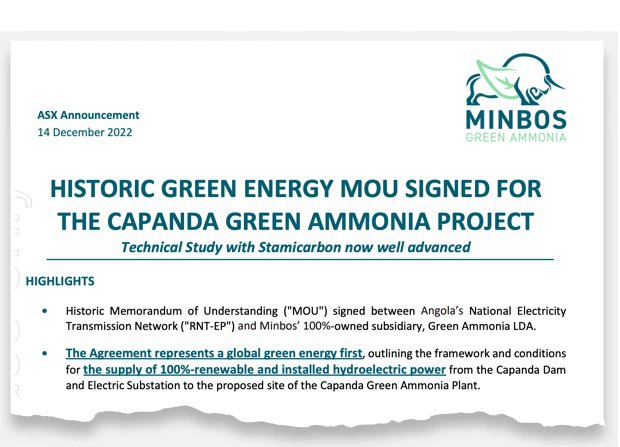
This deal is hugely important in securing the future of MNB’s green ammonia project, which adds a “blue sky” element that complement MNB’s phosphate mine that is now in construction.
MNB has been talking about this cheap power agreement for seven months and we were waiting to see the agreement executed, which we think now qualifies MNB to become our 2022 Wise-Owl Pick of the Year.
This also sees MNB added to our Wise-Owl Portfolio, which Invests in later stage companies with strong management that have established traction and entered into a growth phase or mine development.
MNB’s two projects are each entering interesting phases at the same time:
Phosphate (fertiliser) project - near term production?
We first Invested in MNB over two years ago for this project,
We liked the low capex and potential speed at which the mine could be built.
The project has now moved out of the “boring” feasibility studies / development phase and into the construction/development phase.
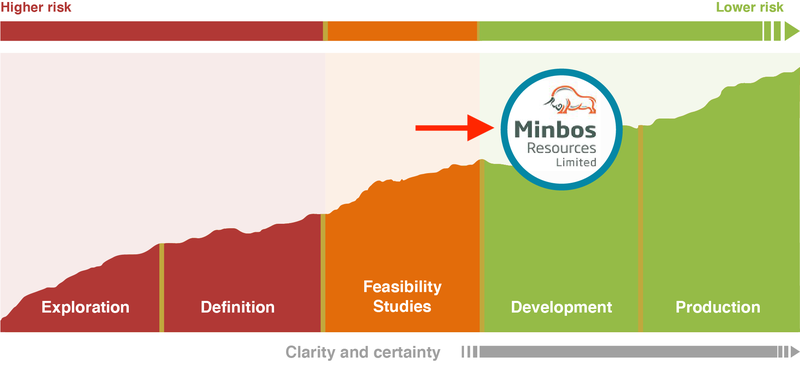
MNB’s phosphate mine is expected to be built and start producing in late 2023.
A resource stock’s move into the construction phase signifies further de-risking of the project. It also marks a move from the traditionally “boring” studies phase as an operational mine moves closer to becoming a reality.
The chart below shows the general share price activity of a junior resource stock as it moves over the project lifecycle phases from exploration to production:
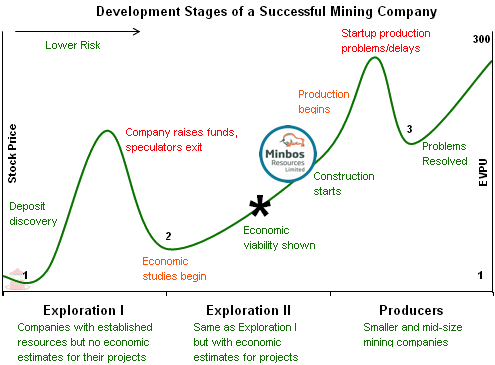
As construction progresses, and the creation of an actual mine looks likely to be achieved, the share price generally trends upwards to reflect the progress - obviously this is a general observation across many projects, but neach individual project comes with its own risks that can materialise and ding the share price.
From here, for MNB’s later stage phosphate mine build, we will be watching to see project financing, offtakes and progress reports on construction.
Green hydrogen/ammonia project - blue sky
The first component of this project is green hydrogen.
Hydrogen is a fuel source produced by separating it from water in a process called “electrolysis”.
This process is energy intensive and much of the world's current hydrogen supply is produced using fossil fuels, namely natural gas - this is called ‘blue or grey hydrogen’.
With gas prices rising globally and the global shift towards renewable energy, we think the future of the hydrogen industry is “green hydrogen” - hydrogen produced using 100% renewable energy.
This is where MNB’s project stands out now that it has a power supply agreement at some of the world’s cheapest electricity prices.
The second component for this project is green ammonia.
Green ammonia is made from green hydrogen, and is easier to store and transport.
Ammonia already has an extensive established market for fertilisers and explosives for mining - MNB plans to sell 50% of its product to either market.
Similar to hydrogen, ammonia prices are surging because expensive natural gas is the key feedstock to produce (blue/grey) Ammonia.
MNB will be running its fertiliser business concurrent to developing this project, so it can opt to vertically integrate its two businesses.
What we want to see next: share price catalysts we are watching for in the next 12 months include signing on technical, offtake, and investment partners for the project.
We also want to see MNB finish its technical studies that will include “plant design, CAPEX and OPEX evaluation and OPEX inputs, including hydroelectric consumption”.
The results of that study will form the basis for a scoping study to get an idea of the green hydrogen/ammonia project’s economics.
The technical study is expected to be delivered in early 2023.
Green ammonia, used in fertilisers and explosives for mining companies, is to be made with hydro-electric power, reducing the reliance on high priced natural gas and without the carbon footprint.
MNB’s two projects provide exposure to the pressing investment thematics of global food security (phosphate production for fertilisers) and renewable energy (green ammonia for use in fertilisers/ explosives).
Events of this year have brought those two issues to the fore, and combined with some major developments from MNB itself, it more than meets the requirements to be named as our Wise Owl Pick of the Year.
These two products each have strong tailwinds supporting high prices and ongoing demand. Fertiliser prices are at near record highs and food security is an increasingly important global issue.
Angola is a potential agricultural powerhouse and MNB is positioning itself as one of the very few local fertiliser product producers in the region.
Our ‘Big Bet’
"MNB delivers a 10x return by building a profitable phosphate mine AND progressing its green ammonia project to construction phase.”
NOTE: our “Big Bet” is what we HOPE the ultimate success scenario looks like for this particular Investment over the long term (3+ years). There is a lot of work to be done, many risks involved - just some of which we list in our MNB Investment Memo. Success will require a significant amount of luck. There is no guarantee that our Big Bet will ever come true.
To see all that MNB has done since we first Invested, see our Progress Tracker:
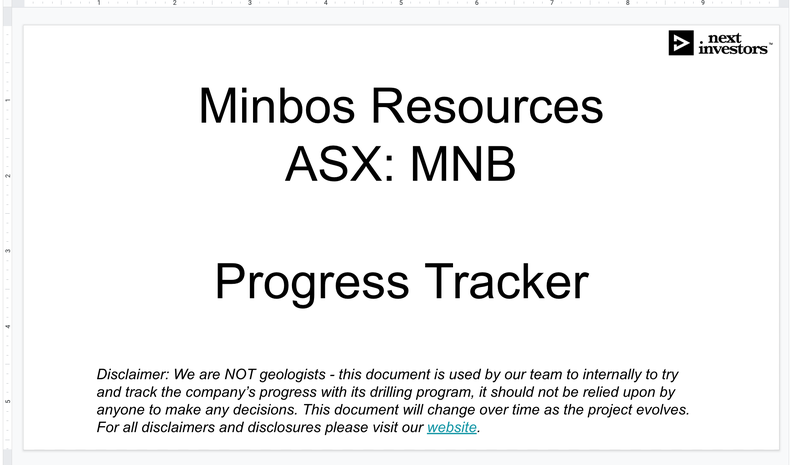
Before we cover how MNB performed on our first Investment Memo, below is our new Investment Memo for MNB. We will use this memo to track the company’s performance over the next 12 months
New MNB Investment Memo #2 - OPEN
Opened: 19 December 2022
Shares Held at Open: 8,645,000
Why are we Invested in MNB?
Short timeline to high-margin phosphate production
Armed with a robust DFS, and with construction underway, we look ahead to first production at MNB’s phosphate project in late 2023. The project is leveraged to fertiliser prices, so the forecast high fertiliser prices and supportive supply-demand dynamics should support the years ahead will work to benefit the project.
Capanda green ammonia project
MNB is exploring green hydrogen / green ammonia production potential in Angola. It is leveraging its support from the Angolan government to ensure access to the country’s local hydro-electric power at what may be the world’s cheapest energy rates.
What do we expect MNB to deliver in the coming 12 months?
Objective #1: Finalise plant construction and first production
- With construction underway at MNB’s phosphate project, we look ahead to first production of its phosphate product by the late 2023 target.
- We want to see MNB secure the required $40M in financing to complete construction.
Milestones
🔲 Secure financing to fund construction completion
🔄 Complete construction of phosphate project - targeting late-2023
🔲 First production
Objective #2: Offtake Agreements or supply MoUs
- We want to see offtake agreements and MoUs signed ahead of initial production - should occur no later than later 2023. A great result would be having an offtake agreement signed/underwritten by the Angolan government. As the project is considered of “National Importance to Angola”, we think this is a possibility.
Milestones
🔄 Enter sales and offtake agreement discussions with Angola’s largest commercial farms
🔲 Offtake agreement 1 signed
🔲 Offtake agreement 2 signed
🔲 Agreements regarding phosphate battery offtakes
Objective #3: Green Ammonia Project progress
- Technical study is now underway with results expected in six months
- We want to see MNB sign an Electricity Supply Contract to secure supply of hydro-electric power upon completion of successful studies under the current supply MOU with Angola’s national energy operator.
- Sign technical, offtake, and investment partners for the development of the proposed Green Hydrogen/Ammonia Project
Milestones
🔄 Completion of technical study
🔲 Sign binding agreement for hydro electricity with Angolan power network operator
🔲 Sign technical, offtake, and investment development partners
What could go wrong?
Sovereign risk
MNB has strong and demonstrated Angolan government support — the government wants to make Angola self-sufficient in fertilisers and to increase agricultural production to ensure food security.
However, investing in Africa does bring additional sovereign risk. The country suffers from high levels of bureaucracy and an underdeveloped financial system, as well as corruption, poor infrastructure, ineffective ports, abundant but unskilled labour and high costs on the ground for businesses.
Therefore, being in this part of Africa means that geopolitical risks form a significant part of MNB’s overall risk profile.
Funding risk
While Angola is not appealing to some investors, completion of the DFS should assist in securing any further financing required to complete construction.
In the 24 months leading to the DFS, anticipated construction costs increased significantly with CAPEX estimates of US$52.6M (complete construction capital costs in the DFS) being well above those in the earlier scoping study (US$22.4–27.9M). Yet building costs inflation goes hand in hand with commodity price and fertiliser price inflation, so MNB’s forecast margins remain high.
The DFS estimated CAPEX remaining of US$40M, but MNB has since said that simplifying the flowsheet would deliver “significant CAPEX savings”, while inflation has also moderated since the peak inflation seen at the time of the DFS release.
Commodity pricing
MNB’s phosphate project is highly leveraged to fertiliser prices. As per the DFS, a ~20% increase in fertiliser prices increases the project’s NPV by $60M (current NPV base case is US$203.4M)
The fertiliser spot price has more than doubled in a year and the supply/demand imbalance could still be further stretched. We expect any further fertiliser price rises to further increase the project NPV.
As for farmers facing increasing costs of fertilisers, the simultaneous food inflation does offset their higher costs, meaning demand for fertilisers should continue.
What is our Investment plan?
We have been Invested in MNB since taking a position at 3c in August 2020. Since then, MNB hit a peak of 18.5c in March 2022 before the share price began to trend back to its current 8c level after a material 11c capital raise was completed in July.
We executed a Top Slice in the first part of the 2022, but also increased our Investment as part of the 11 cent capital raise.
While the share price is off its peak, we are holding for further re-rates as mine construction is completed, offtakes are signed, phosphate production begins, and progress is made on the green hydrogen/ammonia side of the business.
Our investment plan in MNB Investment Memo #2 is to hold a significant position into first production, if the share price nears our 1,000% gain target we will likely sell another ~25% of our position to take some profit and achieve Free Carry.
How did MNB perform against our previous Investment Memo
We publish Investment Memos on each stock we Invest in so that we can benchmark and measure its performance over a set period of time.
For more information read our explainer of how we track and assess our investments using Investment Momos
Here is how we graded MNB on its performance against our MNB Investment Memo #1 from March 2022. We will do the same for the Investment Memo we released today, in ~12 to 18 months.
Investment Memo #1: Minbos Resources Ltd (ASX:MNB) - CLOSED
Opened: 11-Mar-2022
Closed: 19-Dec-2022
Shares Held at Open: 4,895,000
Shares Held at Close: 8,645,000
Reason Memo #1 Closed: Highly Material Announcement - Energy MoU signed with Angolan power network for green hydrogen/ammonia project.
What does MNB do?
Minbos Resources (ASX:MNB) is sitting on a large phosphate resource in Angola that has the potential to dramatically transform the country’s food security and crop yields.
Phosphate is a key ingredient in fertiliser, and MNB will mine the raw phosphate rock, then truck it to a major Angolan port via existing infrastructure.
At the port, it will be enhanced and sold as a blended product to agricultural distribution networks across the country.
What is the macro theme?
Fertiliser prices rose sharply in 2021 and food security is a major issue as supply chains get squeezed in the pandemic. In a broad-based commodities supercycle, phosphate prices are poised to go higher.
[Memo Assessment - 19-Dec-2022]: Grade A
Fertiliser and phosphate prices have continued to rise through 2022 with food security an ongoing global issue.
Why did we invest in MNB?
Phosphate prices rising means better DFS
With phosphate prices rising sharply in 2021-22, we expect the upcoming DFS to show improved project economics and eventually re-rate the share price.
[Memo Assessment - 19-Dec-2022]: Grade = B
The DFS showed higher projected project NPV at current spot prices. Rising fertiliser prices helped to improve projected project economics, but given rising inflation, CAPEX figures were also higher than forecast in the earlier Scoping Study (this is the case for every revised DFS we have seen in the last 12 months)
Delivery of the DFS did not markedly re-rate the MNB share price higher, much of which may be attributed to poor wider market sentiment for speculative investments.
Mine construction
The potential for MNB to begin mine construction in late 2022 is a big drawcard. We think that construction commencing would signal to the markets that MNB have gone from explorer to producer which could lead to the market valuing MNB as a far less risky and more established company.
[Memo Assessment - 19-Dec-2022]: Grade = B
Mine construction had actually commenced in early-2022, and while this does help in derisking the project, it has not carried over to the company’s market valuation.
Green ammonia optionality
MNB has recently committed to exploring green ammonia production potential in Angola utilising the ample access to cheap hydro power.
[Memo Assessment - 19-Dec-2022]: Grade = A
A technical study (the basis for a Scoping Study) has commenced and is expected to be completed in six months from September 2022.
Angola’s electricity network operator, RNT-EP, confirmed its support for a long-term hydro-electricity offtake agreement which would ensure crucial cheap and green electricity supply - a key reason for us calling MNB our Wise Owl Pick of the Year.
What do we expect MNB to deliver in 2022?
Objective #1: Definitive Feasibility Study and Project Financing
We want to see MNB deliver the DFS to better understand the economics of the project and help move MNB into the financing phase
[Memo Assessment - 19-Dec-2022]: Grade = A
The DFS has been delivered. It forecast strong margins with a significant immediate-term sales opportunity. It estimated a project post-tax NPV of US$203M (base case) to US$400M (at current fertiliser prices) at MNB’s 85% ownership.
This compares to MNB’s market cap of just $58M and is an increase on the NPV of US$159-US$260M in the August 2021 Scoping Study.
Objective #2: Plant Construction and first production
- With long lead items already ordered and the final environmental permitting expected to be lodged by the end of Q1-2022, we want to see construction commence at both its plant and mine.
- We will be extremely happy if MNB shares a photo of the first bag of phosphate from the project in 2022, even if it’s from the commissioning or pre-production phase of the project build.
[Memo Assessment - 19-Dec-2022]: Grade: B-
While construction has commenced, first production is now anticipated late-2023, having been pushed back from mid-2022 as was previously anticipated.
MNB still requires fInal environmental approvals for the project.
Seeing first production in 2022 was a long shot, which was reflected in our language on the second point above.
Objective #3: Offtake Agreements or supply MoUs
- We expect this to be the next step after the DFS is delivered. We expect that as the company looks to source project financing and/or commences construction it will turn its focus to signing offtake agreements.
- A great result for MNB will be if the offtake agreement is signed/underwritten by the Angolan government. The project was considered to be of “National Importance to Angola” by the government so we think this is a possibility.
[Memo Assessment - 19-Dec-2022]: Grade = C
We await news of offtake agreements and MoUs, but with the phosphate project DFS in hand, MNB is in a much stronger position to sign some deals.
The signing of these deals has now been pushed into our new MNB Investment Memo #2
We gave MNB a “C” grade on this objective however, because it indirectly made progress by bringing on some interesting investors in its last cap raise who are also potential offtakers.
A $15M cornerstone investment into MNB in July was from a syndicate of investors led by the chairman of the world’s largest battery anode producer.
The syndicate is led by Hong Kong based Mr Liang Feng who is also founder and chairman of Shanghai listed “Shanghai Putailai New Energy Technology” which has a market cap of US$18 billion and is the world’s largest anode materials maker for lithium batteries.
In China, lithium-iron-phosphate batteries make up 44% of EV’s, hence the interest from this group in a large stake of MNB’s future phosphate mine.
Objective #4: Green Ammonia progress
We want to see MNB make some more progress with respect to outlining its Green Ammonia strategy. As part of this process we want to see MNB make progress with the sourcing of renewable energy power and to sign technology partnerships for the development of the plant.
[Memo Assessment - 19-Dec-2022]: Grade = B
MNB signed strategic cooperation agreement with a syndicate of investors, Longmarch - led by Hong Kong based Mr Liang Feng - for its green ammonia/hydrogen project to:
- Investigate the availability of hydropower for new green ammonia projects.
- Evaluate/develop potential downstream ammonia products.
- Complete feasibility studies on a large-scale ammonia project.
- Secure financing to fund construction of production facilities and help securing a suitable site
- Secure customers and offtake arrangements for the ammonia products
What could go wrong?
Geographic risk
Whilst MNB has strong government support, there is always a risk of geopolitical instability in this part of Africa. There have been four coups in the last 4 years in the West Africa region. Geopolitical risks form a significant part of MNB’s overall risk profile.
[Memo Assessment - 19-Dec-2022]: Grade = Unchanged
This risk remains, however MNB has made progress in further developing positive relationships with the Angolan government, particularly in regard to securing hydro-electric power for its green ammonia project.
Funding risk
MNB’s project is located in Angola which may make it difficult to attract financing with investors thinking the geopolitical risk is too high to make large CAPEX investments in the country. MNB is approaching a juncture where it will need to look to raise the full upfront CAPEX required to put its project into production which means this is another big part of the risk profile when investing in MNB.
[Memo Assessment - 19-Dec-2022]: Grade = B
The cost to complete construction of the phosphate project was US$52.6M, but with work already underway the remaining CAPEX is US$48.5M.
Of this, MNB requires further funding of US$40M to complete project construction and provide initial working capital.
MNB’s June share Placement (to raise $25M) was paired with a non-binding debt term sheet for a further US$25 million which it may opt to utilise.
While the DFS will certainly help in attracting and securing financing, the geopolitical risk remains a constant.
Commodity pricing
Fertiliser prices could impact the economic viability of MNB’s project. MNB will also need to produce the fertiliser at a low cost to be able to attract interest from domestic purchasers who have for a long time avoided the usage of fertiliser due to affordability issues.
[Memo Assessment - 19-Dec-2022]: Grade = A
Fertiliser prices were trading at record highs in 2022. MNB’s phosphate project is highly leveraged to fertiliser prices. For this reason the project NPV estimate of US$400M using current phosphate prices is around double the base case NPV estimate of US$203M calculated using historical phosphate prices.
As for farmers facing increasing costs of fertilisers, the simultaneous food inflation does offset their higher costs, meaning demand for fertilisers should continue.
Building costs inflation
With construction costs globally increasing significantly over the last 12-24 months, MNB is at risk of being exposed to large cost overruns as it gets closer towards putting its project into development. Cost inflation may also impact project economics.
[Memo Assessment - 19-Dec-2022]: Grade = B
CAPEX estimates were increased in the DFS (to US$52.6M complete construction capital cost) above those in the earlier scoping study (up from US$22.4–27.9M). We assume that at least part of this increase is related to higher building materials costs. This cost inflation was signalled by MNB management ahead of the release of the DFS so were anticipated.
Yet as building costs inflation goes hand in hand with commodity price and fertiliser price inflation, MNB’s forecast margins remain high.
We note that the DFS was completed during a time of extremely high short term inflation, so would be surprised if CAPEX remains as high as indicated.
Also since the DFS, MNB has said that simplifying the phosphate flowsheet would deliver “significant CAPEX savings”.
What is our Investment plan?
We have been Invested in MNB since August 2020, and in that time it has delivered many key milestones and the share price has experienced two sustained re-ratings.
MNB has been a very successful Investment for us so far - we have a free carried position going into the construct and production phase per our plan with all our Investments, and we expect further re-rates.
Our plan is to hold our position into first production, if the share price nears our 1000% gain target we will likely sell another 20% of our position to take some profit.
[Memo Assessment - 19-Dec-2022]: Grade = B
We executed a Top Slice (sell to de-risk position) in the first part of 2022, and also increased our Investment as part of the 11 cent capital raise in July.
General Information Only
S3 Consortium Pty Ltd (S3, ‘we’, ‘us’, ‘our’) (CAR No. 433913) is a corporate authorised representative of LeMessurier Securities Pty Ltd (AFSL No. 296877). The information contained in this article is general information and is for informational purposes only. Any advice is general advice only. Any advice contained in this article does not constitute personal advice and S3 has not taken into consideration your personal objectives, financial situation or needs. Please seek your own independent professional advice before making any financial investment decision. Those persons acting upon information contained in this article do so entirely at their own risk.
Conflicts of Interest Notice
S3 and its associated entities may hold investments in companies featured in its articles, including through being paid in the securities of the companies we provide commentary on. We disclose the securities held in relation to a particular company that we provide commentary on. Refer to our Disclosure Policy for information on our self-imposed trading blackouts, hold conditions and de-risking (sell conditions) which seek to mitigate against any potential conflicts of interest.
Publication Notice and Disclaimer
The information contained in this article is current as at the publication date. At the time of publishing, the information contained in this article is based on sources which are available in the public domain that we consider to be reliable, and our own analysis of those sources. The views of the author may not reflect the views of the AFSL holder. Any decision by you to purchase securities in the companies featured in this article should be done so after you have sought your own independent professional advice regarding this information and made your own inquiries as to the validity of any information in this article.
Any forward-looking statements contained in this article are not guarantees or predictions of future performance, and involve known and unknown risks, uncertainties and other factors, many of which are beyond our control, and which may cause actual results or performance of companies featured to differ materially from those expressed in the statements contained in this article. S3 cannot and does not give any assurance that the results or performance expressed or implied by any forward-looking statements contained in this article will actually occur and readers are cautioned not to put undue reliance on forward-looking statements.
This article may include references to our past investing performance. Past performance is not a reliable indicator of our future investing performance.


